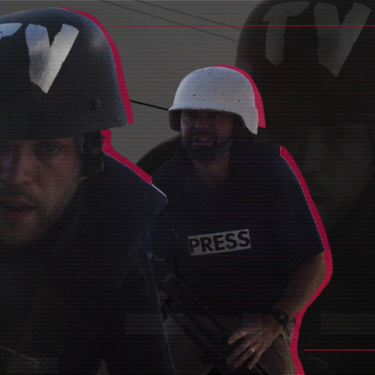Ukraine: a year of information warfare in numbers

With the help of its Ukrainian partner, the Institute of Mass Information (IMI), Reporters Without Borders (RSF) has put numbers to the acts of violence and abuses against journalists and media outlets in Ukraine – and to the resources deployed to support reliable journalism and combat Russian propaganda – in the year since Russia launched its invasion on 24 February.
Read in Ukrainian / Читати українською
Read in Russian / Читать на русском
A total of 12,000 Ukrainian and foreign journalists have been accredited to cover the war in Ukraine in the past year. Exposed to frequent bombardment and often deliberately targeted by Russian forces, they risk their lives every day to report what is happening. While the situation is particularly alarming for journalists in the occupied areas, all of the Ukrainian media have been hit hard by the war and its repercussions.
- 8 journalists killed
Most of the eight journalists killed during the first six months of the war were killed outright or fatally wounded by gunfire or artillery fire. They include Frédéric Leclerc-Imhoff, a French journalist who was in a truck that was targeted by the Russian armed forces. Some, like the Ukrainian photojournalist and fixer Maks Levin, were executed in cold blood. In other cases, such as that of Mantas Kvedaravicius, a Lithuanian documentary filmmaker who was found dead in Mariupol, the circumstances of his death are still unknown.
- 26 journalists knowingly targeted
Of the 50 cases registered by RSF of journalists who came under rifle fire or artillery fire, at least 26 of them were deliberately targeted as journalists.
- 19 journalists injured
Of the 19 Ukrainian and foreign journalists who were wounded, at least four sustained serious injuries. Most were the victims of Russian artillery bombardment or missile strikes but some sustained gunshot injuries. They include the Danish journalists Stefan Weichert and Emil Filtenborg Mikkelsen, who were shot at by an automatic rifle in the northeast of the country.
- 16 TV towers targeted by air strikes
Civilian infrastructure used for transmitting news and information has been a favourite target for Russian forces. Almost half of the attacks on television towers, which have taken place throughout the country, were registered in the first days of the war, in early March 2022. In all, the Russian armed forces have targeted Ukrainian TV towers 16 times in the past year.
- 4 types of media infrastructure targeted
As well as TV towers, the Russian armed forces have often targeted repeater antennae and every other kind infrastructure used for the transmission of communications. As the Russian forces entered the city of Melitopol, in the south of the Zaporizhzhia region, they cut short the broadcasting of Ukrainian TV programmes by taking control of the TV antenna. The Russians jammed the satellite signal of UA Pershiy, one of the channels of the Ukrainian public broadcasting group Suspilne, three times. The Russian armed forces have also taken control of all Internet and mobile phone providers in the occupied areas, depriving their inhabitants of access to news and information.
- 7 war crimes complaints
RSF has filed seven war crimes complaints with the International Criminal Court and Ukraine’s prosecutor-general for a total of 44 acts of violence and abuses involving more than 100 journalists and 11 radio and TV towers in Ukraine. These crimes confirm that the Russian armed forces have been waging an all-out war on news and information.
- 42 cyber-crimes against media
The information war has been waged online as well, using cyber-attacks, hacks, social media threats, and attacks against media pages on social media. At least 42 cyber-crimes have been registered in the past year. The latest cyber-attack, targeting the website of the Ukrainian news agency Ukrinform, was attributed to hackers linked to the GRU, the Russian military intelligence agency.
- 217 media closed
A total of 217 Ukrainian media outlets have had to close for reasons that include supply problems, loss of subscribers and advertisers, lack of staff because employees have fled the country or have been mobilised, and financial losses resulting from destruction. According to a survey by IMI, RSF's local partner, 15% of media workers have been suspended from work without salary.
Unprecedented resources sent to support the right to information
- 750 journalists supplied with protective equipment
Thanks to the creation of a Press Freedom Centre in Lviv on 11 March 2022 and in Kyiv two months later by RSF, with help from the IMI and other local organisations including the National Union of Journalists of Ukraine (NUJU), a total of nearly 750 journalists of 36 nationalities (mostly Ukrainian) have been supplied with individual protective equipment including bulletproof vests, helmets and first aid/trauma kits.
- 91 media supplied with power sources
To offset a lack of electricity resulting from Russian strikes on energy infrastructure, RSF has provided generators and other power supply equipment to 91 media outlets in 14 of Ukraine’s regions so that they can keep operating.
- 28 media funded
So that they can continue working, assistance grants have been provided to 28 independent Ukrainian media outlets that had been very badly hit by the war.
- 288 journalists trained
A thousand copies of a safety guide for journalists were printed and distributed after it had been translated into Ukrainian, and the Ukrainian-language version continues to be available online. A total of 288 journalists have so far received training in physical safety, psychological safety and first aid. No fewer than 90% of Ukrainian journalists report feeling the clinical symptoms of stress, according to an IMI survey.
- 129 journalists assisted financially
In cooperation with several local partners, RSF has provided 129 Ukrainian journalists, including 86 women, with individual financial assistance. RSF plans to continue assisting Ukrainian journalists in 2023.
Assistance requests should be sent to the Press Freedom Centre: [email protected].
The Press Freedom Centre’s activities are supported, inter alia, by and in partnership with:

